Human Orbital Spaceflights
![]()
International Flight No. 75Soyuz T-4PhotonUSSR |
![]()
Launch, orbit and landing data
walkout photo |
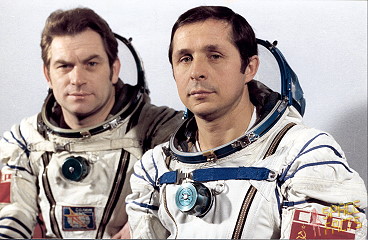 |
|||||||||||||||||||||||
alternative crew photo |
alternative crew photo |
|||||||||||||||||||||||
alternative crew photo |
alternative crew photo |
|||||||||||||||||||||||
alternative crew photo |
alternative crew photo |
|||||||||||||||||||||||
Crew
| No. | Surname | Given names | Position | Flight No. | Duration | Orbits | |
| 1 | Kovalyonok | Vladimir Vasiliyevich | Commander | 3 | 74d 17h 37m 23s | 1178 | |
| 2 | Savinykh | Viktor Petrovich | Flight Engineer | 1 | 74d 17h 37m 23s | 1178 |
Crew seating arrangement
|
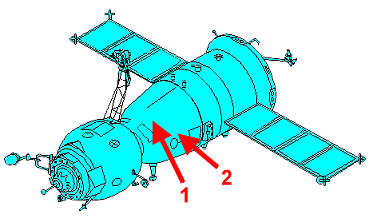 |
|
||||||||||||
Backup Crew
|
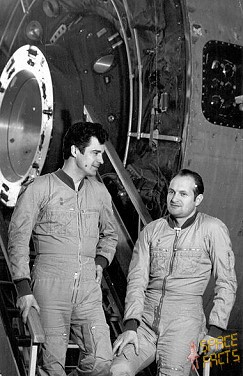 |
Hardware
| Launch vehicle: | Soyuz-U (No. Ts15000-266) |
| Spacecraft: | Soyuz T-4 (7K-ST No. 10L) |
Flight
|
Launch from the Baikonur Cosmodrome and
landing 125 km east of Dzheskasgan. The Soyuz-T was a major upgrade over previous Soyuz spacecraft, sporting solid-state electronics for the first time and a much more advanced onboard computer to help overcome the chronic docking problems that affected cosmonauts during space station missions. In addition, solar panels returned, allowing the Soyuz-T to fly up to 11 days independently as well as a redesigned propulsion system. Finally, it could at last carry three cosmonauts with pressure suits. Following a one-day solo flight Soyuz T-4 docked with Salyut 6 on March 13, 1981. The docking with Salyut 6 was delayed after the onboard Argon computer determined it would occur outside of radio range with the TsUP. The cosmonauts became the fifth and final resident crew of the Salyut 6 space station. Soyuz T-4 arrived at Salyut 6 on March 13, 1981, having been preceded by the Progress 12 resupply craft. After unloading the Progress, it was cast off on March 19, 1981, clearing the docking port for Soyuz 39. Soyuz 39 docked on March 23, 1981 with the first Mongolian cosmonaut (Zhugderdemidiyn Gurragcha) aboard. The fifth resident crew assisted the Intercosmos crew with station equipment and oriented the station according to the needs of the visiting crew's experiments. On March 24, 1981 the cosmonauts installed cosmic ray detectors in the work and transfer compartments. On March 26, 1981 the cosmonauts performed the Illyuminator ('viewing port') experiment, which studied the degradation of the station's viewports. On March 27, 1981 Vladimir Kovalyonok and Viktor Savinykh used the Gologramma ('hologram') apparatus to image a viewing port damaged by micrometeoroids. They repeated this March 28, 1981, when they also collected samples of the station's air and microflora and removed the cosmic ray detectors for return to Earth. March 28, 1981 and March 29, 1981 were largely devoted to studies of Mongolia from space. The visiting crew checked out their spacecraft on March 29, 1981. The visiting crew departed the next day, leaving the fifth resident crew alone aboard the station until May 15, 1981. In mid-May 1981, Vladimir Kovalyonok and Viktor Savinykh replaced the Soyuz T-4 probe with a Salyut drogue. This may have been an experiment to see if a Soyuz-T docked to a space station could act as a rescue vehicle in the event that an approaching Soyuz-T equipped with a probe experienced docking difficulty and could not return to Earth. On May 15, 1981, Soyuz 40 arrived. This was the last flight of the Soyuz ferry model and the last Soyuz spacecraft to dock with Salyut 6. It also ended the first phase of the Interosmos program by carrying Romanian cosmonaut Dumitru Prunariu and Soviet cosmonaut Leonid Popov to the station. Dumitru Prunariu studied Earth's magnetic field. Earth observations had to be delayed until the last day of his flight, when Salyut 6 at last passed over Romania in daylight. During this time the crew also tested the station's orientation system. The Soyuz spacecraft is composed of three elements attached end-to-end - the Orbital Module, the Descent Module and the Instrumentation/Propulsion Module. The crew occupied the central element, the Descent Module. The other two modules are jettisoned prior to re-entry. They burn up in the atmosphere, so only the Descent Module returned to Earth. The deorbit burn lasted about 3 to 4 minutes. Having shed two-thirds of its mass, the Soyuz reached Entry Interface - a point 400,000 feet (121.9 kilometers) above the Earth, where friction due to the thickening atmosphere began to heat its outer surfaces. With only 23 minutes left before it lands on the grassy plains of central Asia, attention in the module turned to slowing its rate of descent. Eight minutes later, the spacecraft was streaking through the sky at a rate of 755 feet (230 meters) per second. Before it touched down, its speed slowed to only 5 feet (1.5 meter) per second, and it lands at an even lower speed than that. Several onboard features ensure that the vehicle and crew land safely and in relative comfort. Four parachutes, deployed 15 minutes before landing, dramatically slowed the vehicle's rate of descent. Two pilot parachutes were the first to be released, and a drogue chute attached to the second one followed immediately after. The drogue, measuring 24 square meters (258 square feet) in area, slowed the rate of descent from 755 feet (230 meters) per second to 262 feet (80 meters) per second. The main parachute was the last to emerge. It is the largest chute, with a surface area of 10,764 square feet (1,000 square meters). Its harnesses shifted the vehicle's attitude to a 30-degree angle relative to the ground, dissipating heat, and then shifted it again to a straight vertical descent prior to landing. The main chute slowed the Soyuz to a descent rate of only 24 feet (7.3 meters) per second, which is still too fast for a comfortable landing. One second before touchdown, two sets of three small engines on the bottom of the vehicle fired, slowing the vehicle to soften the landing. The fifth resident crew departed on May 26, 1981 leaving the Soyuz T orbital module attached to the station for five days. This procedure was first followed on Soyuz-T 3, though then the module was left attached to the station for only a few hours. |
Photos / Graphics
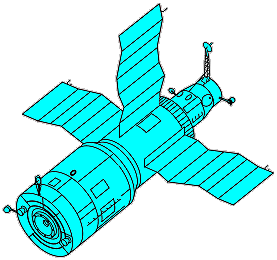 |
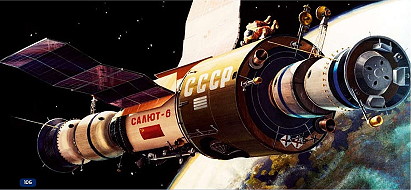 |
 |
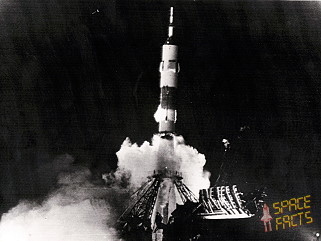 |
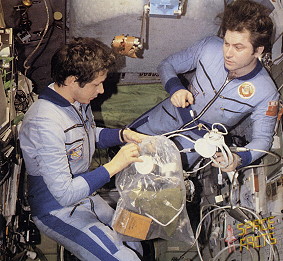 |
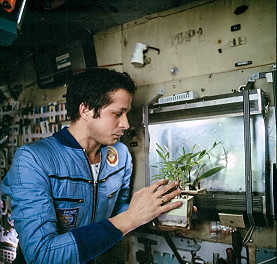 |
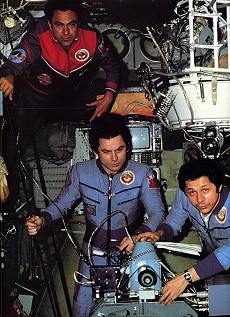 |
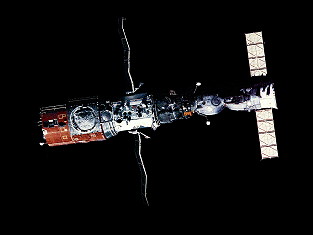 |
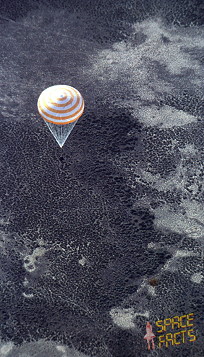 |
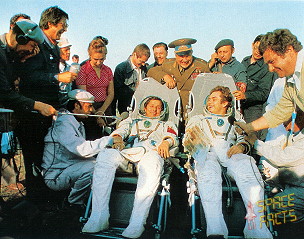 |
| © |  |
Last update on March 09, 2025.  |
 |